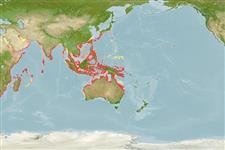Common names from other countries
>
Pleuronectiformes (Flatfishes) >
Cynoglossidae (Tonguefishes) > Cynoglossinae
Etymology: Paraplagusia: Greek, para = the side of + Greek, plagos, plagios = oblique.
More on author: Bloch.
Environment: milieu / climate zone / depth range / distribution range
Ecologia
marinhas; estuarina demersal; intervalo de profundidade 1 - 25 m (Ref. 30573). Tropical; 33°N - 32°S, 30°E - 154°E
Indo-Pacific: Red Sea and east coast of Africa to the Philippines, north to southern Japan, south to New Guinea and northeastern Australia.
Tamanho / Peso / Idade
Maturity: Lm ? range ? - ? cm
Max length : 31.6 cm TL macho/indeterminado; (Ref. 94837); common length : 25.0 cm TL macho/indeterminado; (Ref. 30573)
Espinhos dorsais (total): 0; Raios dorsais (total): 99-115; Espinhos anais 0; Raios anais : 72 - 89; Vértebras: 50. Upper side tan, marbled with dark wavy lines enclosing pale patches; 2 lateral lines on eyed side, none on blind side (Ref. 4418). Caudal vertebrae 36-44; mid-lateral line scales 75-109 (Ref. 9224, 11691).
Found on mud and sand bottoms of the continental shelf (Ref. 30573). Enters shallow estuarine waters (Ref. 4833) and tidal rivers (Ref. 1479).
Ciclo de vida ou comportamento de acasalamento
Maturidade | Reprodução | Desova | Ovos | Fecundidade | Larvas
Masuda, H., K. Amaoka, C. Araga, T. Uyeno and T. Yoshino, 1984. The fishes of the Japanese Archipelago. Vol. 1. Tokai University Press, Tokyo, Japan. 437 p. (text). (Ref. 559)
Status na Lista Vermelha da UICN (Ref. 130435)
CITES (Ref. 128078)
Not Evaluated
Ameaça para os humanos
Harmless
Uso pelos humanos
Pescarias: pouco comercial
Ferramentas
Relatórios especiais
Baixar XML
Fontes da internet
Estimates based on models
Preferred temperature (Ref.
115969): 25 - 29.2, mean 28.5 (based on 2940 cells).
Índice de diversidade filogenética (Ref.
82804): PD
50 = 0.5156 [Uniqueness, from 0.5 = low to 2.0 = high].
Bayesian length-weight: a=0.01259 (0.00598 - 0.02651), b=2.99 (2.79 - 3.19), in cm Total Length, based on LWR estimates for this species & (Sub)family-body (Ref.
93245).
Nível Trófico (Ref.
69278): 3.5 ±0.4 se; based on size and trophs of closest relatives
Resiliência (Ref.
120179): Elevada, tempo mínimo de duplicação da população menor que 15 meses (Preliminary K or Fecundity.).
Fishing Vulnerability (Ref.
59153): Low vulnerability (22 of 100).
